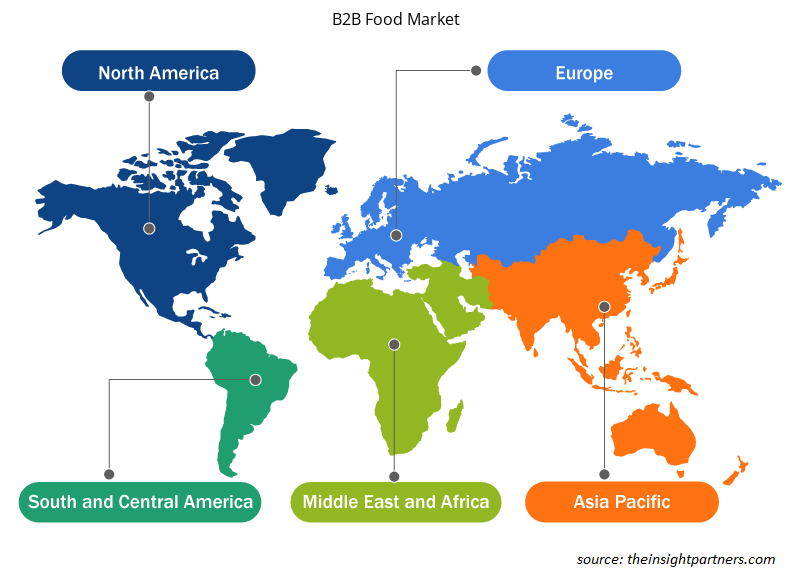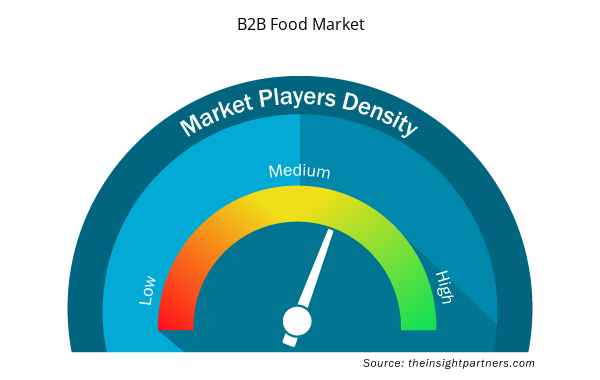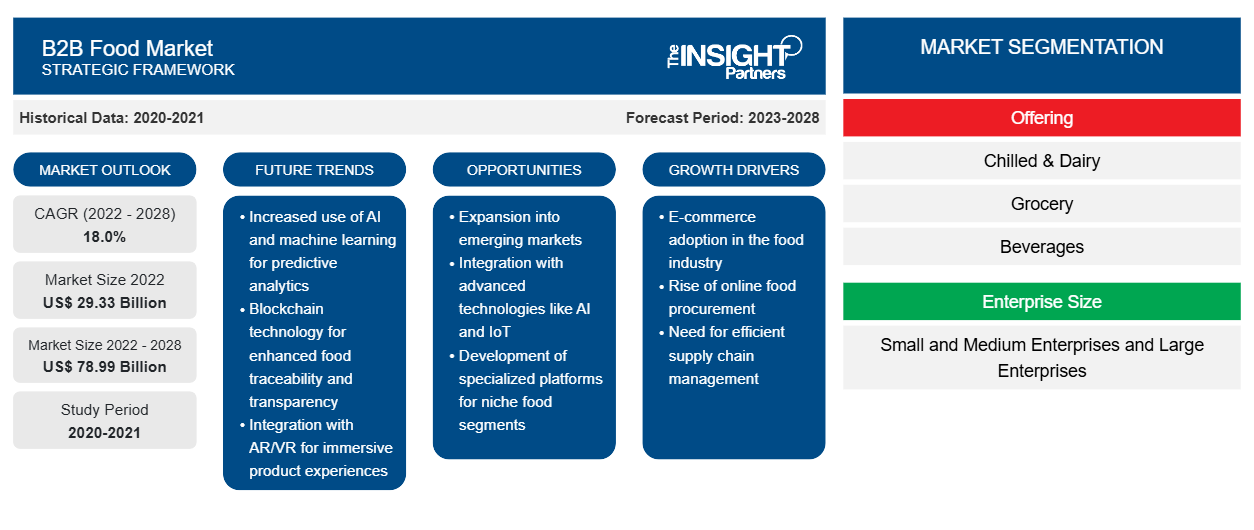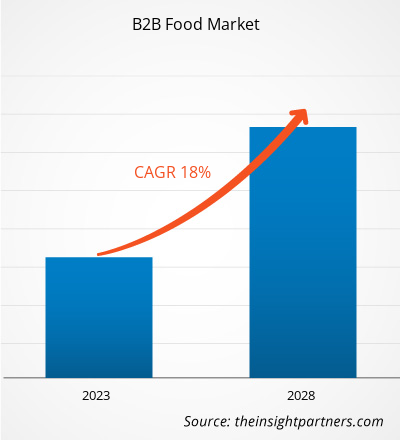Si prevede che il mercato delle piattaforme di mercato alimentare B2B crescerà da 29.326,79 milioni di dollari nel 2022 a 78.988,62 milioni di dollari entro il 2028; si prevede che crescerà a un CAGR del 18,0% dal 2022 al 2028.
Le piattaforme di mercato alimentare B2B collegano acquirenti e venditori in tutto il mondo. I venditori su queste piattaforme possono essere produttori o venditori, mentre gli acquirenti possono essere rivenditori, venditori e operatori del settore della ristorazione, come ristoranti, hotel e mense. Queste piattaforme vengono utilizzate per il commercio di alimenti trasformati e non trasformati. Il mercato delle piattaforme di mercato alimentare B2B sta vivendo una crescita significativa grazie alla proliferazione di smartphone e tablet, che facilitano una migliore comunicazione tra PMI e acquirenti. Inoltre, la determinazione dei prezzi contrattuali dei prodotti sta alimentando la crescita del mercato delle piattaforme di mercato alimentare B2B. La crescente adozione di prodotti alimentari confezionati, la crescita del settore della ristorazione dovuta all'aumento del reddito disponibile e alla crescente inclinazione verso uno stile di vita moderno e la fiorente industria delle energie rinnovabili offshore continueranno probabilmente a spingere la crescita del mercato delle piattaforme di mercato alimentare B2B nei prossimi anni. La pandemia di COVID-19 ha avuto un impatto positivo sulla crescita del mercato delle piattaforme di mercato alimentare B2B poiché acquirenti e venditori optano per soluzioni digitali per le operazioni aziendali.
Le aziende fornitrici attraggono i consumatori offrendo sconti o offerte speciali sui loro prodotti o quando viene acquistato un certo volume. Fornitori e aziende stipulano spesso accordi sui prezzi a livello aziendale e il prezzo di mercato di un dato articolo viene mantenuto costante. Anche nel settore alimentare B2B viene mantenuta la trasparenza dei prezzi. Questa dinamica in genere avvantaggia i fornitori, che possono adottare una strategia di discriminazione dei prezzi basata sulla capacità e sulla volontà di pagare dei clienti. Ad esempio, eFoodChoice.com è una società di piattaforma online alimentare B2B che aiuta i venditori e gli acquirenti di cibo internazionali ad espandere i loro canali di merchandising, sviluppare il loro business online a livello internazionale e aumentare in modo sostenibile la loro redditività. A seconda della quantità di beni, la società fornisce un intervallo di prezzi esclusivo per gli acquirenti. La società ha anche stabilito quantità minime di ordine (MOQ) per ciascuna categoria di prodotti. Con tale prezzo contrattuale dei prodotti, gli utenti finali possono selezionare il numero ottimale di beni a un prezzo equo, innescando la domanda per il mercato della piattaforma di mercato alimentare B2B.
Personalizza questo report in base alle tue esigenze
Riceverai la personalizzazione gratuita di qualsiasi report, comprese parti di questo report, o analisi a livello nazionale, pacchetto dati Excel, oltre a usufruire di grandi offerte e sconti per start-up e università
- Scopri le principali tendenze di mercato in questo rapporto.Questo campione GRATUITO includerà analisi di dati che spaziano dalle tendenze di mercato alle stime e alle previsioni.
Impatto della pandemia di COVID-19 sul mercato delle piattaforme di mercato alimentare B2B APAC
La pandemia di COVID-19 ha avuto un impatto grave sui paesi APAC in quanto sono densamente popolati, il che ha aumentato il rischio di diffusione del SARS-CoV-2. Secondo l'Organizzazione per la cooperazione e lo sviluppo economico (OCSE), nel 2020 la pandemia ha colpito le principali economie come Cina, India, Australia e Giappone, che stanno sperimentando l'inflazione. Le limitazioni imposte dai governi dei paesi APAC per controllare la diffusione del COVID-19 hanno avuto un impatto negativo sul settore alimentare e delle bevande. La chiusura di hotel, ristoranti e attività di catering ha ridotto l'adozione delle piattaforme di mercato alimentare B2B nell'economia dell'Asia Pacifica, poiché le consegne online sono state limitate a causa del blocco. Tuttavia, nel terzo trimestre del 2020, hotel, ristoranti e attività di catering hanno riavviato le loro attività, che dovrebbero crescere nei prossimi anni. Inoltre, il crescente turismo porterà alla crescita del settore della ristorazione nella regione, il che alimenterà ulteriormente la crescita del mercato delle piattaforme di mercato alimentare B2B durante il periodo di previsione.
Market Insights – Piattaforma di mercato alimentare B2B
La crescente adozione di piattaforme di e-commerce aumenta la domanda di piattaforme di mercato alimentare B2B
Un aumento degli acquisti online è attribuito al crescente numero di rivenditori online e mercati virtuali in tutto il mondo. Le piccole imprese, i minimarket e le società di e-commerce si stanno sempre più concentrando su soluzioni sofisticate come le piattaforme di mercato. Queste piattaforme aiutano nella gestione e nel controllo efficienti ed efficaci delle loro operazioni e dei loro processi. Inoltre, la crescente enfasi sulla digitalizzazione da parte di rivenditori fisici, negozi di alimentari e aziende start-up, nonché i crescenti ricavi derivanti dalle vendite online, stanno favorendo l'espansione del mercato delle piattaforme di mercato alimentare B2B negli Stati Uniti. La riduzione delle barriere commerciali transfrontaliere in tutto il mondo sta creando significative opportunità per venditori e aziende, in particolare negli Stati Uniti, di estendere la portata dei loro prodotti a livello internazionale. Le aziende di e-commerce, i centri commerciali e altre attività, come piccoli negozi e botteghe, si stanno rivolgendo ai mercati online per vendere i loro prodotti, il che sta aumentando la crescita del mercato delle piattaforme di mercato alimentare B2B.
Approfondimenti di mercato basati sulle categorie alimentari
In base alla categoria alimentare, il mercato della piattaforma del mercato alimentare B2B è suddiviso in prodotti refrigerati e latticini, generi alimentari, bevande e altri. Il segmento dei generi alimentari ha rappresentato la quota maggiore del mercato nel 2021. In termini di categoria alimentare, i generi alimentari sono molto richiesti in ogni angolo del mondo. Con l'aumento della popolazione, la domanda è aumentata in modo significativo. La crescente domanda di riso, cereali, farina e amidi, cibo istantaneo e pasti pronti da cucinare sta guidando il mercato del segmento dei generi alimentari. La crescita della popolazione giovane e il cambiamento degli stili di vita stanno creando un'enorme domanda di cibo istantaneo e pasti pronti da cucinare. Si prevede che questo fattore stimolerà la crescita del mercato del mercato alimentare B2B nei prossimi anni. Inoltre, sta crescendo anche la domanda di altri prodotti alimentari come prodotti biologici, ingredienti alimentari, oli, noci, erbe aromatiche, salse, spezie, semi e dolcificanti e prodotti a base di miele, con conseguente quota dominante del segmento nel mercato del mercato alimentare B2B.
Cibo B2B
Piattaforma di mercato alimentare B2B Approfondimenti regionali di mercato
Le tendenze regionali e i fattori che influenzano il mercato delle piattaforme di mercato alimentare B2B durante il periodo di previsione sono stati ampiamente spiegati dagli analisti di Insight Partners. Questa sezione discute anche i segmenti e la geografia del mercato delle piattaforme di mercato alimentare B2B in Nord America, Europa, Asia Pacifico, Medio Oriente e Africa e America meridionale e centrale.

- Ottieni i dati specifici regionali per il mercato della piattaforma di mercato alimentare B2B
Ambito del rapporto di mercato sulla piattaforma del mercato alimentare B2B
| Attributo del report | Dettagli |
|---|---|
| Dimensioni del mercato nel 2022 | 29,33 miliardi di dollari USA |
| Dimensioni del mercato entro il 2028 | 78,99 miliardi di dollari USA |
| CAGR globale (2022 - 2028) | 18,0% |
| Dati storici | 2020-2021 |
| Periodo di previsione | 2023-2028 |
| Segmenti coperti | Offrendo
|
| Regioni e Paesi coperti | America del Nord
|
| Leader di mercato e profili aziendali chiave |
|
Piattaforma di mercato alimentare B2B Densità dei player del mercato: comprendere il suo impatto sulle dinamiche aziendali
Il mercato delle piattaforme di mercato B2B Food Marketplace sta crescendo rapidamente, spinto dalla crescente domanda degli utenti finali dovuta a fattori quali l'evoluzione delle preferenze dei consumatori, i progressi tecnologici e una maggiore consapevolezza dei vantaggi del prodotto. Con l'aumento della domanda, le aziende stanno ampliando le loro offerte, innovando per soddisfare le esigenze dei consumatori e capitalizzando sulle tendenze emergenti, il che alimenta ulteriormente la crescita del mercato.
La densità degli operatori di mercato si riferisce alla distribuzione di aziende o società che operano in un particolare mercato o settore. Indica quanti concorrenti (operatori di mercato) sono presenti in un dato spazio di mercato in relazione alle sue dimensioni o al valore di mercato totale.
Le principali aziende che operano nel mercato delle piattaforme di mercato alimentare B2B sono:
- CiboMaven
- Amazzone
- eFoodChoice.com
- Tecnologie Cheetah Inc.
- Eworldtrade.com
Disclaimer : le aziende elencate sopra non sono classificate secondo un ordine particolare.

- Ottieni la panoramica dei principali attori del mercato della piattaforma B2B Food Marketplace
Gli operatori che operano nel mercato delle piattaforme di mercato alimentare B2B si concentrano principalmente sullo sviluppo di prodotti avanzati ed efficienti.
- Nel 2022, Cheetah ha chiuso un round di finanziamento di serie C per un totale di 60 milioni di dollari e ha annunciato di aver concluso tre transazioni di acquisizione con Palo Alto Foods, Esteson e Joseph Martin Foods.
- Nel 2022, Pod Foods ha lanciato Pod Foods Capital, uno strumento di finanziamento che consente ai marchi emergenti di accedere a capitali facili e convenienti per aiutarli a far crescere il loro marchio.
Tra i principali attori profilati nel mercato delle piattaforme di mercato alimentare B2B figurano FoodMaven, Amazon, eFoodChoice.com, Cheetah technologies Inc., Eworldtrade.com, FoodsTrade, Ufoodin, Pod foods Co., Emerge Srl e Notch.
- Analisi storica (2 anni), anno base, previsione (7 anni) con CAGR
- Analisi PEST e SWOT
- Valore/volume delle dimensioni del mercato - Globale, regionale, nazionale
- Industria e panorama competitivo
- Set di dati Excel



Report Coverage
Revenue forecast, Company Analysis, Industry landscape, Growth factors, and Trends

Segment Covered
This text is related
to segments covered.

Regional Scope
North America, Europe, Asia Pacific, Middle East & Africa, South & Central America

Country Scope
This text is related
to country scope.
Domande frequenti
The global market size of B2B food marketplace platform market by 2028 will be around US$ 78,988.62 million
The China holds a major market share of B2B food marketplace platform market in 2022
The estimated global market size for the B2B food marketplace platform market in 2022 is expected to be around US$ 29,326.79 million
The factors such as better communications between SMEs and buyers due to smartphones and tablets and contract-based pricing of products are contributing to the growth of the market
Thailand, Malaysia and Mexico register high growth rate during the forecast period
An increase in online purchasing is attributed to the growing number of online retailers and virtual marketplaces across the world. Small enterprises, c-stores, and e-commerce corporations are increasingly focusing on sophisticated solutions such as marketplace platforms. E-commerce companies, shopping malls, and other businesses, such as small stores and shops, are turning to online marketplaces to sell their products, which is boosting the B2B food marketplace platform industry.
Grocery segment is expected to hold a major market share of B2B food marketplace platform market in 2022
Asia Pacific is expected to register highest CAGR in the B2B food marketplace platform market during the forecast period (2022-2028)
FoodMaven; Amazon; eFoodChoice.com; Cheetah technologies Inc.; and Eworldtrade.com are the key market players expected to hold a major market share of B2B food marketplace platform market in 2022
Trends and growth analysis reports related to Technology, Media and Telecommunications : READ MORE..
The List of Companies - B2B Food Marketplace Platform Market
- FoodMaven
- Amazon
- eFoodChoice.com
- Cheetah technologies Inc.
- Eworldtrade.com
- FoodsTrade
- Ufoodin
- Pod foods Co.
- Emerge Srl
- Notch
The Insight Partners performs research in 4 major stages: Data Collection & Secondary Research, Primary Research, Data Analysis and Data Triangulation & Final Review.
- Data Collection and Secondary Research:
As a market research and consulting firm operating from a decade, we have published and advised several client across the globe. First step for any study will start with an assessment of currently available data and insights from existing reports. Further, historical and current market information is collected from Investor Presentations, Annual Reports, SEC Filings, etc., and other information related to company’s performance and market positioning are gathered from Paid Databases (Factiva, Hoovers, and Reuters) and various other publications available in public domain.
Several associations trade associates, technical forums, institutes, societies and organization are accessed to gain technical as well as market related insights through their publications such as research papers, blogs and press releases related to the studies are referred to get cues about the market. Further, white papers, journals, magazines, and other news articles published in last 3 years are scrutinized and analyzed to understand the current market trends.
- Primary Research:
The primarily interview analysis comprise of data obtained from industry participants interview and answers to survey questions gathered by in-house primary team.
For primary research, interviews are conducted with industry experts/CEOs/Marketing Managers/VPs/Subject Matter Experts from both demand and supply side to get a 360-degree view of the market. The primary team conducts several interviews based on the complexity of the markets to understand the various market trends and dynamics which makes research more credible and precise.
A typical research interview fulfils the following functions:
- Provides first-hand information on the market size, market trends, growth trends, competitive landscape, and outlook
- Validates and strengthens in-house secondary research findings
- Develops the analysis team’s expertise and market understanding
Primary research involves email interactions and telephone interviews for each market, category, segment, and sub-segment across geographies. The participants who typically take part in such a process include, but are not limited to:
- Industry participants: VPs, business development managers, market intelligence managers and national sales managers
- Outside experts: Valuation experts, research analysts and key opinion leaders specializing in the electronics and semiconductor industry.
Below is the breakup of our primary respondents by company, designation, and region:

Once we receive the confirmation from primary research sources or primary respondents, we finalize the base year market estimation and forecast the data as per the macroeconomic and microeconomic factors assessed during data collection.
- Data Analysis:
Once data is validated through both secondary as well as primary respondents, we finalize the market estimations by hypothesis formulation and factor analysis at regional and country level.
- Macro-Economic Factor Analysis:
We analyse macroeconomic indicators such the gross domestic product (GDP), increase in the demand for goods and services across industries, technological advancement, regional economic growth, governmental policies, the influence of COVID-19, PEST analysis, and other aspects. This analysis aids in setting benchmarks for various nations/regions and approximating market splits. Additionally, the general trend of the aforementioned components aid in determining the market's development possibilities.
- Country Level Data:
Various factors that are especially aligned to the country are taken into account to determine the market size for a certain area and country, including the presence of vendors, such as headquarters and offices, the country's GDP, demand patterns, and industry growth. To comprehend the market dynamics for the nation, a number of growth variables, inhibitors, application areas, and current market trends are researched. The aforementioned elements aid in determining the country's overall market's growth potential.
- Company Profile:
The “Table of Contents” is formulated by listing and analyzing more than 25 - 30 companies operating in the market ecosystem across geographies. However, we profile only 10 companies as a standard practice in our syndicate reports. These 10 companies comprise leading, emerging, and regional players. Nonetheless, our analysis is not restricted to the 10 listed companies, we also analyze other companies present in the market to develop a holistic view and understand the prevailing trends. The “Company Profiles” section in the report covers key facts, business description, products & services, financial information, SWOT analysis, and key developments. The financial information presented is extracted from the annual reports and official documents of the publicly listed companies. Upon collecting the information for the sections of respective companies, we verify them via various primary sources and then compile the data in respective company profiles. The company level information helps us in deriving the base number as well as in forecasting the market size.
- Developing Base Number:
Aggregation of sales statistics (2020-2022) and macro-economic factor, and other secondary and primary research insights are utilized to arrive at base number and related market shares for 2022. The data gaps are identified in this step and relevant market data is analyzed, collected from paid primary interviews or databases. On finalizing the base year market size, forecasts are developed on the basis of macro-economic, industry and market growth factors and company level analysis.
- Data Triangulation and Final Review:
The market findings and base year market size calculations are validated from supply as well as demand side. Demand side validations are based on macro-economic factor analysis and benchmarks for respective regions and countries. In case of supply side validations, revenues of major companies are estimated (in case not available) based on industry benchmark, approximate number of employees, product portfolio, and primary interviews revenues are gathered. Further revenue from target product/service segment is assessed to avoid overshooting of market statistics. In case of heavy deviations between supply and demand side values, all thes steps are repeated to achieve synchronization.
We follow an iterative model, wherein we share our research findings with Subject Matter Experts (SME’s) and Key Opinion Leaders (KOLs) until consensus view of the market is not formulated – this model negates any drastic deviation in the opinions of experts. Only validated and universally acceptable research findings are quoted in our reports.
We have important check points that we use to validate our research findings – which we call – data triangulation, where we validate the information, we generate from secondary sources with primary interviews and then we re-validate with our internal data bases and Subject matter experts. This comprehensive model enables us to deliver high quality, reliable data in shortest possible time.


 Ottieni un campione gratuito per questo repot
Ottieni un campione gratuito per questo repot